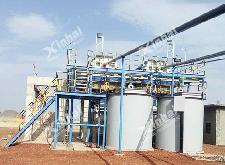

Warm Tip: If you want to know more details about equipment, solutions, etc, please click the button below for free consultation, or leave your requirements!

In the entire beneficiation process of a concentrator, grinding operation cost accounts for a considerable proportion. The grinding fitness is one of the main factors affecting the mineral processing index,which will directly affect both the grade of concentrate and the recovery rate of product. Therefore, how to improve grinding fineness of the ball mill becomes an important part of controlling grinding operation cost.
However,is the grinding fitness the finer the better in grinding operation?
In actual production, some concentration plants think that the finer the grinding fineness, the easier it is to improve dressing efficiency. However, this cognition has led to a lot of winding courses in the processing plant, which not only greatly reduces mineral recovery rate, but also increase investment and operating expenses of the concentrator in vain.
According to the research and practice, the factors affecting the grinding fitness are: raw ore hardness, crushing particle size, grid sieve hole, ball mill model, steel balls number, steel ball size ratio, ball mill liner wear, ball mill speed, extension speed, the height of the extension spindle, the wear of the extension blade, the height of the opening under the extension, the size of the opening under the extension, the height of the opening on the extension, the size of the opening on the extension, the size of the water at the returning sand, the water supply of the ball mill, and the flushing capacity at the discharge port of ball mill. Only adjusting these influencing factors accurately can the grinding fitness be controlled in a suitable range.
In fact, the characteristics of ore will greatly affect the grinding fitness, each ore has its unique grindability and selectivity. If the grinding particle is too coarse, the metal minerals can't be sufficiently separated from the gangue or harmful elements, resulting in low concentrate grade and recovery rate. However, if the grinding particle is too fine, although the metal minerals are sufficiently separated from the gangue or harmful elements, it will also cause more fine ore particles that are difficult to separate. At this time, the phenomenon of over-grinding is likely to occur. In this case, many useful metal minerals will loss with water in vain, which not only reduces the concentrate grade and recovery rate, but also increase greatly ball mill's consumption caused by an ineffective and unnecessary grinding operation, thus increasing mineral processing cost and finally affecting the economic indicators of mineral processing. Therefore, it's necessary to determine the grinding fitness according to the type of ore.
After extensive trials and project practice, Xinhai Mining's technology experts found that even if the grinding fitness is finest, the recovery rate is not necessarily the highest. Therefore, the traditional concept, “the finer the grinding fineness, the better”, is completely wrong. In terms of grinding fineness, Xinhai Mining's technology experts also pointed out that grinding fineness is usually determined by the beneficiation test to determine an optimal grinding size range. Generally, the grinding product of the ball mill is mainly measured by screening. The more the percentage under the screening, the finer the grinding. Therefore, neither too coarse nor too fine grinding fitness is advisable. Only an appropriate grinding fineness is the necessary beneficiation condition for separating useful metal minerals from gangue or harmful elements.
Taking the Dandong Linjia Sandaogou Gold Mine as an example, the ore has a finer mineral dissemination particle size, which is a typical arsenic-containing, sulfur-containing, fine-grained refractory gold ore. Therefore, a reasonable grinding fineness defined before flotation operation is a key factor to improve the mineral recovery rate. Through the analysis of the relationship between the grinding fineness of the Sandaogou gold mine and the mineral dressing index, as well as mathematical analysis of the grinding fineness inspection test and the existing production data, it is finally determined that when the grinding fineness is -200 mesh and accounts for 92% or more, the optimum economic and technical indicators of mineral processing can be achieved. This conclusion has been applied in the production practice of the factory, and verified by industrial production. The above theory and practice fully demonstrate the importance of proper grinding fineness. It's also very important to choose a ball mill to achieve proper grinding fineness.
Therefore, in the selection of grinding equipment, Xinhai mining's dressing technology experts suggest that the concentrators should chose the appropriate ball mill according to their own production needs and grinding fitness needs determined by ore properties. However, because many concentrators don't have clear grinding fineness requirements, many mine owners still aren't able to choose the right grinding equipment. In view of the fact that the fineness of grinding is the result of numerous mineral dressing tests, Xinhai Mining's dressing technology experts suggest that when purchasing grinding equipment, it is better to inform ball mill manufacturers of mineral properties and grinding test results, to consult professionals for advice and not to arbitrarily determine the fineness of the grinding, for fear that wrong theory bring about mistakes in the production process and the occurrence of safety accidents.
Last: How Many Things Do You Know About Mine Design?
Next: 3 Principles of Choosing the Crushing and Grinding Process
1What is Ball Mill?
 0
0
 3807
3807
2What Is The Selection Basis of Ball Mill, Autogenous Mill And Rod Mill Respectively?
 3
3
 3423
3423
3Ball Mill: Is the Grinding Fineness the Finer, the Better?
 10
10
 6356
6356


What Are the Differences Between CIP and CIL?
 11336
11336
 0
0